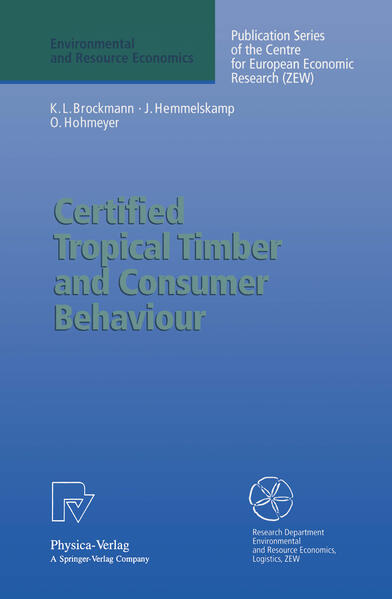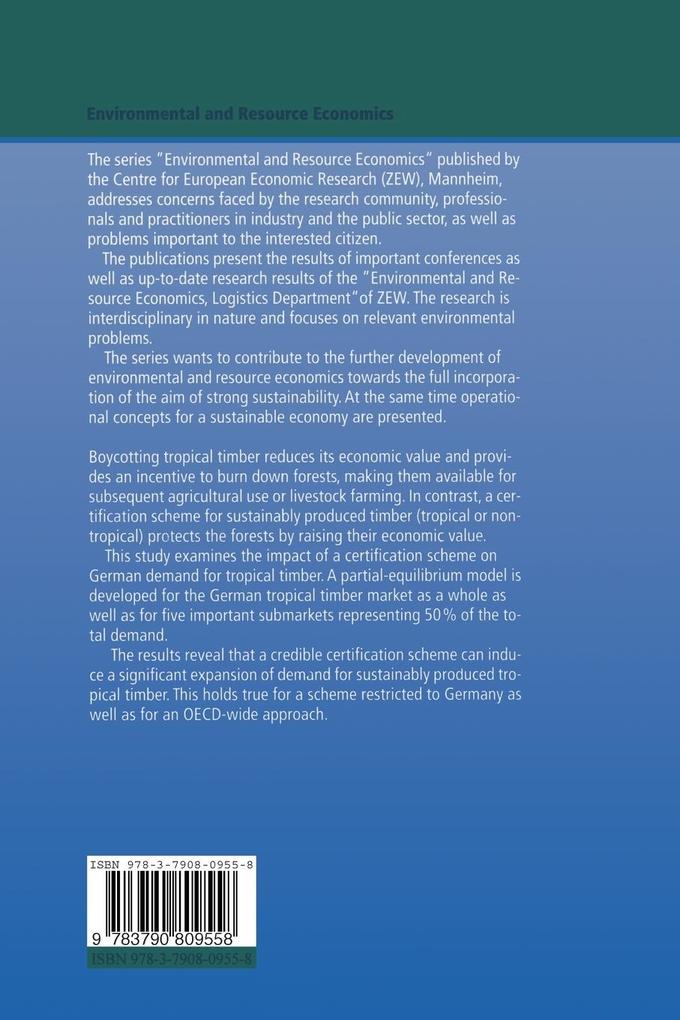
Zustellung: Fr, 15.08. - Mo, 18.08.
Versand in 2 Tagen
VersandkostenfreiBestellen & in Filiale abholen:
Boycotting tropical timber reduces its economic value and provides an incentive to burn down forests, making them available for subsequent agricultural use or livestock farming. In contrast, a certification scheme for sustainably produced timber (tropical or non-tropical) protects the forests by raising their economic value. Examined here the impact of a certification scheme on German demand for tropical timber. A partial-equilibrium model is developed for the German tropical timber market as a whole as well as for five important submarkets representing 50% of the total demand. The results reveal that a credible certification scheme can induce a significant expansion of demand for sustainably produced tropical timber. This holds true for a scheme restricted to Germany as well as for an OECD-wide approach.
Inhaltsverzeichnis
1 Introduction. - I: General Conditions for Tropical Timber Certification. - 2 Concepts of Sustainability and the Design of a Certification Scheme for Tropical Timber. - 3 Effectiveness and Efficiency of a Certification Scheme Aimed at Protecting Tropical Rain Forests. - 4 Certification and Tropical Timber Supply. - 5 Environmental Labels and Consumer Behaviour. - II: Basic Scenarios for a Certified Tropical Timber Market in the Federal Republic of Germany. - 6 Definitions, Database and Data Processing. - 7 Distribution of Tropical Timber in the Federal Republic of Germany. - 8 Trend Analysis and Basic Scenarios. - III: Extended Scenarios for a Certified Tropical Timber Market under Different Supply and Demand Constellations. - 9 Theoretical Foundations. - 10 Extended Scenarios for Individual Submarkets. - 11 Extended Scenarios of the Aggregate Timber Market. - 12 Conclusions. - A1 Procedure for Evaluating the Foreign Trade Statistics. - A2 Production Quantities and Values of Lacquer of German Production. - A3 List of Goods Categories in the Foreign Trade Statistics as Information Source for Tropical Timber. - A4 Net Imports of Tropical Timber into the Federal Republic of Germany. - A5 Conversion Factors for Evaluating the Foreign Trade Statistics. - A6 Recovery Rates. - A7 Domestic Final Consumption of Tropical Timber in the Federal Republic of Germany in 1984. - A8 Half-Finished Tropical Timber Products: Chief Uses and Substitutes. - A9 Finished Timber Products on the German Market Containing No or Negligible Tropical Timber from Natural Forests. - A10 Graphic Depiction of a Contracting or Expanding Demand. - A11 Determining the Reaction Directions of the Derived Demand. - Summary.
Mehr aus dieser Reihe
Produktdetails
Erscheinungsdatum
10. Juli 1996
Sprache
englisch
Untertitel
The Impact of a Certification Scheme for Tropical Timber from Sustainable Forest Management on German Demand.
Auflage 1996.
Sprache: Englisch.
Auflage
1996
Seitenanzahl
196
Reihe
Environmental and Resource Economics
Autor/Autorin
Karl L. Brockmann, Jens Hemmelskamp, Olav Hohmeyer
Verlag/Hersteller
Produktart
kartoniert
Gewicht
306 g
Größe (L/B/H)
235/155/11 mm
ISBN
9783790809558
Entdecken Sie mehr
Bewertungen
0 Bewertungen
Es wurden noch keine Bewertungen abgegeben. Schreiben Sie die erste Bewertung zu "Certified Tropical Timber and Consumer Behaviour" und helfen Sie damit anderen bei der Kaufentscheidung.












